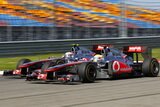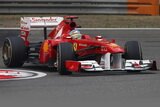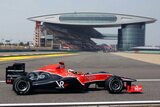The Silverstone of 1950 was a far cry from the modern circuit we know today and there was little to disguise its airfield origins, with hay bales for barriers and scaffolding for stands. It may not have been glamorous, but that didnt stop motor racings international elite turning out. The event also had the royal seal of approval, with King George VI becoming the first reigning English monarch to attend the Grand Prix.
The powerhouse in the paddock was Alfa Romeo, who brought their all-conquering 158 cars and the formidable 'Three Fs' to pilot them - Argentina's Juan Manuel Fangio and Italians Nino Farina and Luigi Fagioli. Alfa were also kind enough to provide a fourth car for British ace Reg Parnell, who thus became the 100,000 crowds best hope of a home win.
The 44 year-old Farina, a protege of the great pre-war driver Tazio Nuvolari, dominated Thursday's and Friday's practice sessions, lapping the then 4.65-kilometre circuit at over 150 km/h in his 1.5 litre supercharged, straight-eight machine. His team mates were close behind, hence it was no surprise that Alfa Romeo went on to fill the grids four-car front row.
Best of the rest in practice, in what was very much a 'second division' behind the Alfas, was the Eton and Cambridge-educated Prince Bira of Siam for Maserati. Then came the first of the cars with normally-aspirated 4.5 litre power (the second of the two engine configurations allowed under the F1 regulations of the time), the French factory Talbot-Lagos of YG Cabantous and Eugene Martin.
The two other manufacturers present were English Racing Automobiles, better known as ERA, and another home contender, Alta. Between them they helped fill out an impressive 21-car grid, with Farina at the front and the Talbot-Lago of Johnny Claes at the rear, the British-raised Belgian's best time a full 18 seconds off pole.
Race morning - Saturday - started with a now unimaginable concept, as Alfa Romeo mechanics drove the teams four 158s the 20-odd kilometres by road from their Banbury base to Silverstone. The cherry-red machines proved an equally impressive spectacle on the track, dominating the Grand Prix from the outset, with Farina, Fagioli and Fangio playfully taking turns to lead in the opening laps as the rest of the field tried and failed to stay in touch.
Unable to keep up with the three flying Fs, Parnell maintained a comfortable fourth place, despite a collision with one of Silverstones infamous hares. Behind him the competition quite literally began to fall apart, with the ERAs of Leslie Johnson and Peter Walker the first casualties, followed by Martin's Talbot-Lago, all retiring with mechanical maladies.
After smooth pit stops for all four Alfas - smooth in 1950 meant 30 seconds or less - the race gradually developed into a showdown between team stalwart Farina and upstart Fangio, who had been signed for the 1950 season on the back of his spectacular (non-championship) F1 form the previous year. This early sign of what would ultimately become an intense rivalry ended when Fangio briefly lost control and broke an oil line, putting him out after 62 of the 70 laps.
His only real threat removed, Farina was able to ease off in the closing laps and, after almost two and three-quarter hours of racing, the Italian took the chequered flag 2.8s ahead of veteran compatriot Fagioli. Parnell was a popular third, albeit almost a minute down, followed by the Talbot-Lagos of Cabantous and Louis Rosier, both two laps off the lead.
Farina's win not only guaranteed him a place in the F1 history books, it also set the tone for a season which would see him go on to become the sport's first world champion, beating Fangio to the crown by three points, each driver having taken three victories.
That first Silverstone race may not have been a classic in the traditional sense, but its significance was immeasurable. Of those who competed that day, few probably imagined that the FIA Formula One World Championship would even exist six decades later, let alone become the world's most watched annual sporting series. Heres to the next 60 years...
formula1.com
Comments:













